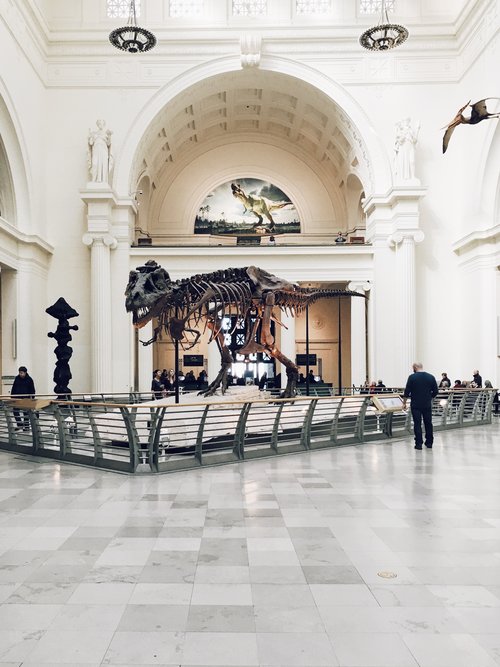AMERICAN ALLIANCE OF MUSEUMS
"Champion museums and nurture excellence in partnership with our members and allies"
A number of years ago, the American Alliance of Museums (AAM, formerly the American Association of Museums) decided to take a big gamble on its membership model. The AAM’s traditional business strategy was almost entirely membership-funded, and the member was the museum, not the individual museum professional or enthusiast. They operated a sliding scale of membership dues based upon the size of the museum. Large and well-funded members like the Guggenheim, The Met, or the Smithsonian paid very high annual dues to the AAM each year, based on total annual funding and revenue. Smaller or underfunded museums typically couldn’t afford memberships. But, because the AAM’s revenue model didn’t depend on them anyway, the organization historically didn’t focus on their inclusion in events, communications, marketing strategies, and other major initiatives. The smaller groups certainly were welcome, but the business model of AAM wasn’t historically designed to allow them to effectively participate.
AAM had been historically successful, but the model was beginning to crack. Their financial position declined as museums around the country experienced funding shortages and fewer visitors, and soon the AAM wondered how it could finance itself any longer.
Drastic times called for drastic measures, so the board went outside the box and hired as its new CEO Ford Bell, a veterinarian by trade who happened to serve on the board of directors for a local museum in his hometown of Minneapolis. Bell was a museum enthusiast, and, along with his unlikely résumé, brought a radical new message: The AAM would completely revamp its membership structure to engage everyone and anyone with an interest in advancing museums. They would no longer focus on engaging wealthy museums as their primary method of financing the mission. Their goal was to more effectively embrace the entire population interested in advancing museums. This included all those who were, had been or who might become members of a museum.

Not only did doing so make more financial sense over the long run, but it also reconnected the organization to a deeply meaningful purpose, which had never been emphasized or realized in the past.
“Our new beginning and brand are designed to help us truly unite the museum field — from art museums to zoos and everything in between — so that we may more effectively advocate for the cause of museums,” Bell said in a statement upon rolling out AAM’s new direction. “Speaking with one voice, the breadth of the U.S. museum field will be able to make the case that museums are essential to our educational infrastructure, essential to our economic prosperity, and essential to building communities everywhere.”
About the decision to change their name from the American Association of Museums to the American Alliance of Museums, chair of the board and COO of the Newark Museum in New Jersey Meme Omogbai explained, “By definition, an alliance is an entity forged for the mutual benefit of all. That is the essence of the new American Alliance of Museums—to re-ignite an organization into one whose aim is to benefit all: our museums, the individuals who work in them, and the communities they serve.”
Bell elaborated on the name change by drawing a line to organizational purpose. “(O)ur new name signals our resolve to unite the museum field so that we can speak with one strong voice. We are no longer the trade association for museums, but rather the cause of museums. Moreover, our new brand goes far beyond mere cosmetics. Our brand as the American Alliance of Museums is emblematic of our commitment to advancing the cause of museums—as well as supporting those who work in museums, donate to them, or simply love them—and the communities served by America’s museums.”

With its purpose now publicly underscored, AAM announced a new tier of membership for professionals that would be free to join. Any individual in the world working in a museum could join the organization at no cost. The AAM’s reasoning behind such a bold decision was to establish itself as the hub of all things related to museums. They wanted to create an open place for everyone to learn more about museums, hoping that by learning more, they would want to become members of, or at least visit, a museum. The AAM was also banking on the idea that its vast collection of information, expertise news, and museum partners would compel those with an interest in museums and museum-related resources to join their organization. They also knew the success of all museums was essential to AAM’s relevancy and thus its own success.
In other words, the Open Garden Model seemed like the best strategy for their future, having realized the interconnected nature of their business’ ecosystem.
Bell and his team also went to the large museum members most responsible for funding the organization in the past and informed them that if they were to take advantage of a free membership right now, the AAM would be gone. They presented their vision for the future of AAM and requested each group maintain their organizational membership. Bell explained they would receive differentiated benefits over time by helping the AAM with its purpose of advancing the cause of museums in the court of public opinion. He then asked these top members to commit to five years at their current level of funding to achieve their mission — a proposal to which every member agreed. They weren’t buying into a great, sure-fire deal exactly; they were buying into a cause they believed in, one they knew that, with enough dedication and vision, would eventually yield better revenue and funding results for the entire museum community. Over that five-year period, the AAM’s individual membership went from basically zero to somewhere in the 50,000 range.
AAM achieved such an outcome by recruiting more organizational members at the museums it served, offering memberships at much smaller dollar amounts to drive up overall membership as well as member engagement. In the past, if you were the director of a small museum who couldn’t afford an AAM membership, you didn’t do anything with AAM. But because AAM opened the door to all, it generated much more revenue from individuals spending comparatively small dollar amounts for courses, certifications, and other benefits. Plus, many new museums joined the organization because of the AAM’s decision to offer a lower pricing tier for museum memberships, while the large museums mostly stayed on as members at the higher price level.
Bell understood that by opening AAM’s doors and rebooting its organizational model, he could expand its presence and gain a much richer set of resources, which ultimately saved the organization from extinction and led it into a new era of prosperity and advancement of its purpose. Driving the board’s decision to hire Bell and go along with this radical vision was a financial crisis, perhaps the most powerful motivator of any business. The AAM was also a 100-plus-year-old organization that had run largely in the same way it had since its founding, so it probably never would have changed if it wasn’t for the fact that it had to change.
The reason the organization managed such a major transition successfully had a lot to do with the leadership team’s preliminary work before they actually executed the changes. Bell, the board, and the executive staff all did their due diligence in assessing the changes that needed to be made, as well as the ways in which they could make them. Much of that research AAM obtained by offering different ways for people to give feedback, which is crucial to any organization, but especially during periods of significant transition.
[accessally_course_navigation prev_button='Previous' next_button='Next']
[progressally_note note_id='1' allow_attachment='no']
Share your progress!
[progressally_social_share type='facebook' share_id='1' post_id='42'][/progressally_social_share][progressally_social_share type='twitter' share_id='1' post_id='42'][/progressally_social_share][progressally_social_share type='email' share_id='1' post_id='42'][/progressally_social_share]
[progressally_progress_bar post_id="5606" width="100%" height="25"]
